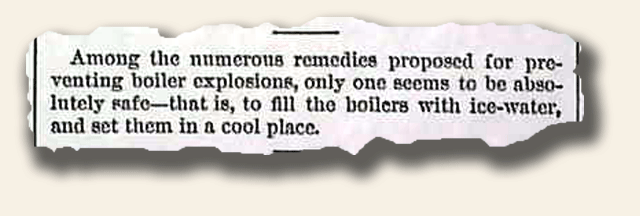Resources of collectors…
April 29, 2010 by GuyHeilenman · 2 Comments
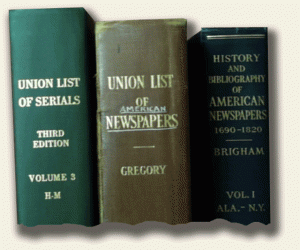 One of the most frequently asked questions regarding the rare newspaper hobby concerns available resources. Awhile back we posted a general response to this on eBay titled, “What Resources are Available for Newspaper Collectors?”. Although we’ll continue to look at this question in detail, we thought newcomers might appreciate a general overview. An excerpt of this post is as follows:
One of the most frequently asked questions regarding the rare newspaper hobby concerns available resources. Awhile back we posted a general response to this on eBay titled, “What Resources are Available for Newspaper Collectors?”. Although we’ll continue to look at this question in detail, we thought newcomers might appreciate a general overview. An excerpt of this post is as follows:
1) Price Guide For Rare & Historic Newspapers?
2) Storage & Display Options For Colonial, Civil War & 20th Century Newspapers?
3) Reference Books On The History Of Old Newspapers?
4) A Club Of Collectors Of Old Newspapers?
Collecting rare & early newspapers from the colonial era through the Civil War & 20th century is a fun & fascinating hobby, but questions often arise: Is their a price guide, or a club of collectors? What storage & display options are recommended for the old newspaper hobbyist? How about reference material on the hobby?
1) Being a relatively unknown hobby has its advantages…
To view the entire post, please go to: “What Resources are Available for Newspaper Collectors?“
First newspapers in Maine…
April 26, 2010 by TimHughes · 1 Comment
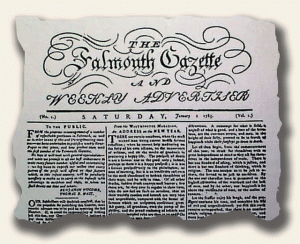 It may be a surprise to some that Maine did not become a state until 1820, much later than most of the other New England states which were among the original thirteen colonies. It was a part of Massachusetts in the 18th century and figured in the Missouri Compromise of 1820 which allowed Missouri to enter the Union as a slave state, balanced by Maine as a free state.
It may be a surprise to some that Maine did not become a state until 1820, much later than most of the other New England states which were among the original thirteen colonies. It was a part of Massachusetts in the 18th century and figured in the Missouri Compromise of 1820 which allowed Missouri to enter the Union as a slave state, balanced by Maine as a free state.
Benjamin Titcomb, a native of Maine, was the first printer in the state and joining with Thomas Wait started the “Gazette and Weekly Advertiser” in Falmouth (now Portland) on January 1, 1785. But just a year later Titcomb left the newspaper and Wait changed the newspaper’s name to the “Cumberland Gazette“, Cumberland being the name of the county in which Falmouth was located. It changed names again six years later to the “Eastern Herald“.
Titcomb’s son, Benjamin Titcomb, Jr., started Maine’s second newspaper on Oct. 8, 1790, called the “Gazette of Maine” and six years later these first two newspapers would be combined to be the “Eastern Herald and Gazette of Maine“.
The other 18th century newspapers published in present-day Maine were the “Eastern Star” in Hallowell. 1794, the “Tocsin” also in Hallowell, 1795, the “Kennebec Intelligencer” in Augusta (then called Harrington) 1795, the “Wiscasset Telegraph” in 1796, “The Gazette” in in Portland, 1798, the “Wiscasset Argus” in 1797, the “Oriental Trumpet” of Portland, 1798, and the “Castine Journal” on Jan. 2, 1799. Many of these titles had a very short life.
A toast to the “multitaskers” of the world…
April 24, 2010 by GuyHeilenman · Leave a Comment
The Harper’s Weekly dated 10/21/1871 apparently had a wealth of wisdom buried within (see last Saturday’s post). The following certainly raises the stock of the “multitaskers” among us:
Featured websites – The Liberator Files…
April 22, 2010 by GuyHeilenman · Leave a Comment
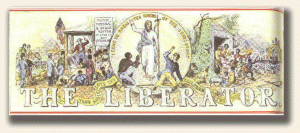 Within the past few months, three members of Timothy Hughes Rare & Early Newspapers each recommended the same website, The Liberator Files, as a great resource for exploring this well-known abolitionist title from the early/mid 1800’s. This Boston paper was published by William Lloyd Garrison, and provides wonderful context for this formative period in U.S. history – from the early 1830’s through the end of the Civil War. The Liberator Files, developed and maintained by Horace Seldon, includes a wealth of abolitionist related commentary in conjunction with a host of scanned Liberator images from William Lloyd Garrison’s own collection, which are currently held at the Boston Public Library. Thanks Horace, for your significant contribution to the world of rare & historic newspapers. Please enjoy!
Within the past few months, three members of Timothy Hughes Rare & Early Newspapers each recommended the same website, The Liberator Files, as a great resource for exploring this well-known abolitionist title from the early/mid 1800’s. This Boston paper was published by William Lloyd Garrison, and provides wonderful context for this formative period in U.S. history – from the early 1830’s through the end of the Civil War. The Liberator Files, developed and maintained by Horace Seldon, includes a wealth of abolitionist related commentary in conjunction with a host of scanned Liberator images from William Lloyd Garrison’s own collection, which are currently held at the Boston Public Library. Thanks Horace, for your significant contribution to the world of rare & historic newspapers. Please enjoy!
Feel free to share with the rare newspapers community other historical and/or rare newspaper oriented websites you’ve found to be of use.
First newspapers in Louisiana…
April 19, 2010 by TimHughes · Leave a Comment
 Being a French settlement from the early 1700’s, it would be of no surprise that the first newspaper in present-day Louisiana was French: “Moniteur de la Louisiane” which began in New Orleans on March 3, 1794. Three years later it became the official mouthpiece of the government, and continued to print until the publisher’s death in July, 1814.
Being a French settlement from the early 1700’s, it would be of no surprise that the first newspaper in present-day Louisiana was French: “Moniteur de la Louisiane” which began in New Orleans on March 3, 1794. Three years later it became the official mouthpiece of the government, and continued to print until the publisher’s death in July, 1814.
Louisiana’s first newspaper done by a publisher of English or American extraction was the “Union: New Orleans Advertiser and Price Current” by James Lyon, of Vermont, which began on Dec. 13, 1803. Just one day later Louisiana’s third newspaper began–a French publication–“Le Telegraphe, et le Commercial Advertiser“. Both these latter two endeavors began just a few months after the Louisiana Purchase. Actually “Le Telegraphe” began as a French publication but later changed to both French and English, a tradition which held true for many Louisiana newspapers at least through the Civil War.
Stating the obvious…
April 17, 2010 by GuyHeilenman · Leave a Comment
Upon browsing an issue of Harper’s Weekly dated 10/21/1871, we came across an interesting tidbit which provides an obvious solution to what must have been a common problem. Please enjoy:
Featured websites – The Boston Journalism Trail…
April 15, 2010 by GuyHeilenman · Leave a Comment
 The Boston Journalism Trail is a fascinating on-line resource for anyone interested in early journalism in America – especially as was present in colonial era newspapers. The website was created and is maintained by Emmanual E. (Manny) Paraschnos, Graduate Program Director and Professor of Journalism at Emerson College, Boston, MA. Manny states, “I was born with ink in my veins…”, a fact which comes through loud and clear as you journey through the material found via The Boston Journalism Trail. Take the time to stroll through this wonderful resource. Click on the various landmarks to see a plethora of images showing the corresponding buildings, and where appropriate, original & historic newspapers. Of particular note is the “About the Boston ‘Newspaper Row’ ” link found at the bottom center of the page.
The Boston Journalism Trail is a fascinating on-line resource for anyone interested in early journalism in America – especially as was present in colonial era newspapers. The website was created and is maintained by Emmanual E. (Manny) Paraschnos, Graduate Program Director and Professor of Journalism at Emerson College, Boston, MA. Manny states, “I was born with ink in my veins…”, a fact which comes through loud and clear as you journey through the material found via The Boston Journalism Trail. Take the time to stroll through this wonderful resource. Click on the various landmarks to see a plethora of images showing the corresponding buildings, and where appropriate, original & historic newspapers. Of particular note is the “About the Boston ‘Newspaper Row’ ” link found at the bottom center of the page.
We owe Manny a debt of gratitude for his many contributions to the historic newspapers community. If you are planning to visit historic Boston, make your first stop The Boston Journalism Trail. Your trip will be enhanced by what you find.
The value of a newspaper… impacted by content…
April 12, 2010 by GuyHeilenman · 7 Comments
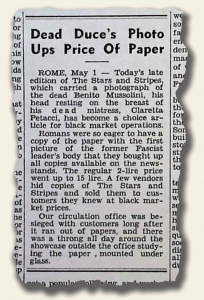 One of the common questions received at Timothy Hughes Rare & Early Newspapers is “What elements are involved in determining the collectible value of a newspaper?” Several posts on this subject may be viewed at: “Determining the Value of an Historic Newspaper“. Two of the elements which drive the collectible value of a paper are content and age. For example, the $0.50-$1.00 newsstand price of a Washington Post, USA Today, or Chicago Tribune with the 1st report on the election of President Obama quickly rose to $35 a month (and higher) after the event (content), and will likely be valued at many times this amount in 20+ years (age).
One of the common questions received at Timothy Hughes Rare & Early Newspapers is “What elements are involved in determining the collectible value of a newspaper?” Several posts on this subject may be viewed at: “Determining the Value of an Historic Newspaper“. Two of the elements which drive the collectible value of a paper are content and age. For example, the $0.50-$1.00 newsstand price of a Washington Post, USA Today, or Chicago Tribune with the 1st report on the election of President Obama quickly rose to $35 a month (and higher) after the event (content), and will likely be valued at many times this amount in 20+ years (age).
In contrast, we recently came across a newspaper whose value increased by more than 700% (due to content – a photo) before the end of the day of its initial printing. Our find… the May 1, 1945 Mediterranean edition of Stars and Stripes. The front cover printed the famous photo of Benito Mussolini shown after his execution. In an effort to show a little discretion, the photo is not shown within this post, but may be viewed at: http://www.rarenewspapers.com/view/568477?acl=779383924
Although there have been times when the collectible value of a newspaper increased by the following day, we’d love to know of other pre-2000 events which resulted in an increase in the value of the newspaper on the same day the issue hit the newsstands. If you know of any, feel free to share with the collectible community.
Food for thought… a little humble pie…
April 10, 2010 by GuyHeilenman · Leave a Comment
While looking for content on the death of General William Walker in an October 6, 1860 issue of Harper’s Weekly, I came across an interesting morsel I thought everyone might enjoy. Just a little something to chew on (sorry):
James Gordon Bennett and his New York Herald…
April 8, 2010 by TimHughes · Leave a Comment
A book I am currently reading, “An Empire of Wealth” by John Steele Gordon, has a page or two concerning newspapers, mostly focused on the innovations of James Gordon Bennett (image to the left is from the Harper’s Weekly dated July 10, 1858) and his “New York Herald“, offering some insights new to me and likely new to you. It is a bit lengthy but has some interesting information I felt was worthy of sharing:
 “The biggest difference between the newspapers of the pre-industrial world and those of today was politics. Most general-interest newspapers were the instruments of political factions, praising one party and excoriating all others. They were, in reality, little more than an editorial page wrapped in some highly tendentious news.
“The biggest difference between the newspapers of the pre-industrial world and those of today was politics. Most general-interest newspapers were the instruments of political factions, praising one party and excoriating all others. They were, in reality, little more than an editorial page wrapped in some highly tendentious news.
A Scots immigrant to New York, James Gordon Bennett, changed all that. Born in 1795 into one of Scotland’s few Catholic families, Bennett was always a man apart, which can be an asset for a journalist. He was also remarkably ugly, with severely crossed eyes. When a young journalist interviewed him in the 1850’s at his office across from New York’s City Hall, he reported that Bennett ‘looked at me with one eye, while he looked out at the City Hall with the other.’
Well educated in Aberdeen, he wrote his first piece of journalism about the Battle of Waterloo, when he was twenty, and four years later, sensing greater opportunity, immigrated to the United States. He worked at a series of newspapers from Boston to Charleston before settling in New York where, three times, he tried to found a newspaper that would expound Jacksonian principles. Each attempt was a failure.
Steam, however, was changing the newspaper business as it was changing everything else by the 1830’s. The new rotary presses, powered by steam, could turn out thousands of copies of a newspaper a night and at a much lower price than had been possible before. Bennett decided to try something new. On May 6, 1835, with $500 in capital, an office in a dank cellar, and himself as the only employee, Bennett began publishing the “New York Herald“.
Bennett made the Herald nonpartisan in its news articles, sought always to be the first with the news, and sold it to a mass audience by having it hawked on the streets at a penny a copy by the armies of newsboys that would quickly become a feature of the American urban scene for more than a hundred years. None of these ideas was original with Bennett. But it was he who put them all together for the first time. He also introduced a dazzling array of other journalistic innovations. He was the first to print a weather report and to cover sports regularly. He was the first to cover business news and stock prices in a general-interest newspaper. And while ‘respectable’ papers weren’t supposed to notice such things, when a beautiful prostitute was murdered in one of New York’s more fashionable brothels, Bennett played the story for all it was worth.
The “Herald’s” circulation soared, and other papers were forced to follow suit as the city, and then the country, became transfixed with the story. Within a few years the ‘Herald” was among the city’s most successful papers. Bennett traveled to Europe, where he signed up correspondents in London, Rome and Paris to supply the “Herald” with exclusive copy, the world’s first foreign correspondents. He fought Congress to establish the principle that out-of-town newspapers had as much right to the congressional press galleries as the local papers, the beginning of the Washington press corps. He even coined the use of the world ‘leak’, to refer to the stores slipped to reporters by politicians for their own purposes.
As the telegraph began to spread across the country, Bennett exploited it to the hilt. When the Mexican Was broke out, only two years after Morse’s successful demonstration, Bennett organized a consortium of newspapers to fund a pony express from New Orleans to Charleston, which was connected to New York by telegraph. The reports the New York papers published were often days ahead of the official reports arriving in Washington.
By the time of the Civil War the “Herald” was, by far, the largest and most influential newspaper in the country, and all other major papers had followed its model, profoundly transforming the newspaper business. Its daily circulation during the war reached as high as 400,000, many times the total circulation of all American newspaper combined fifty years earlier.”




